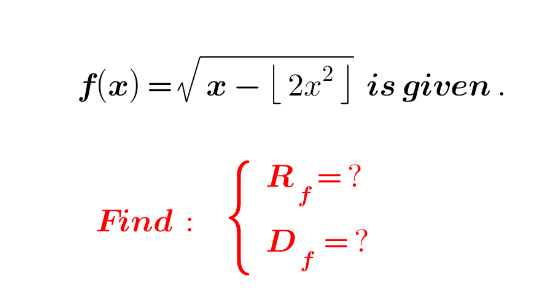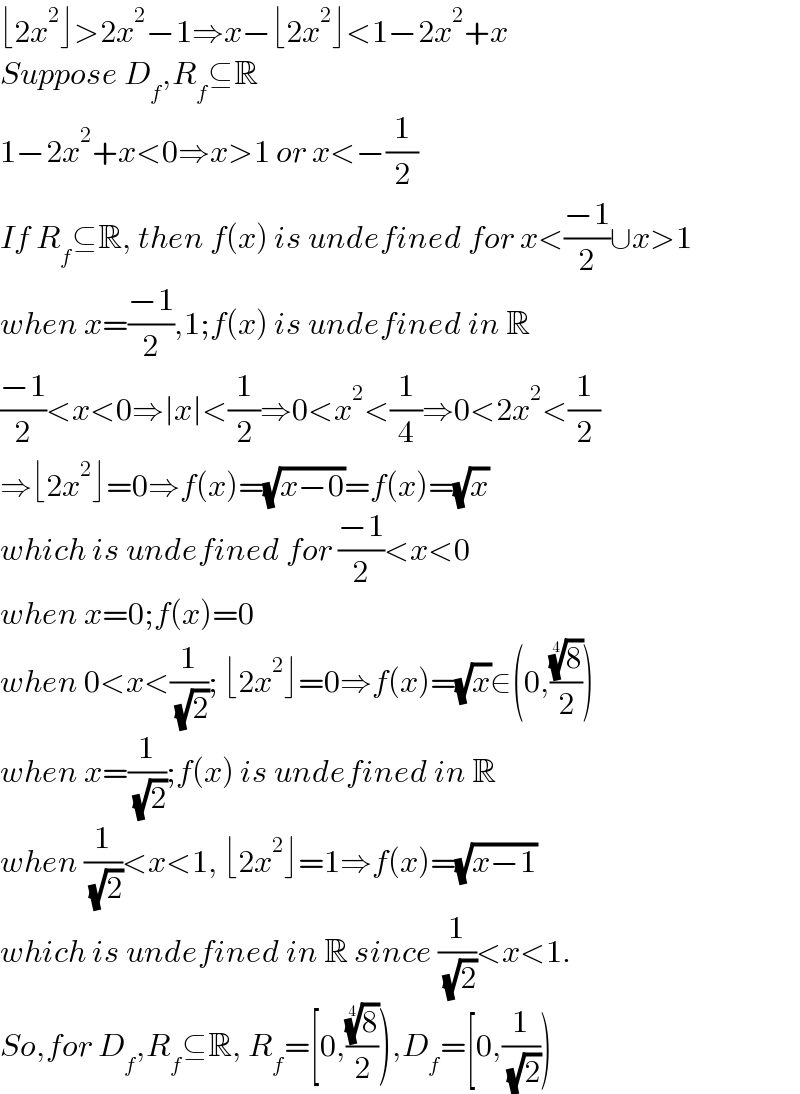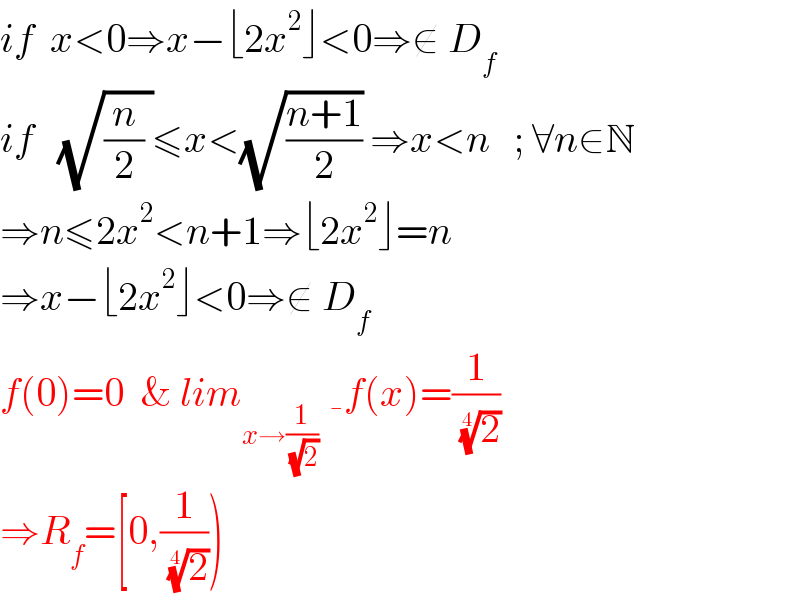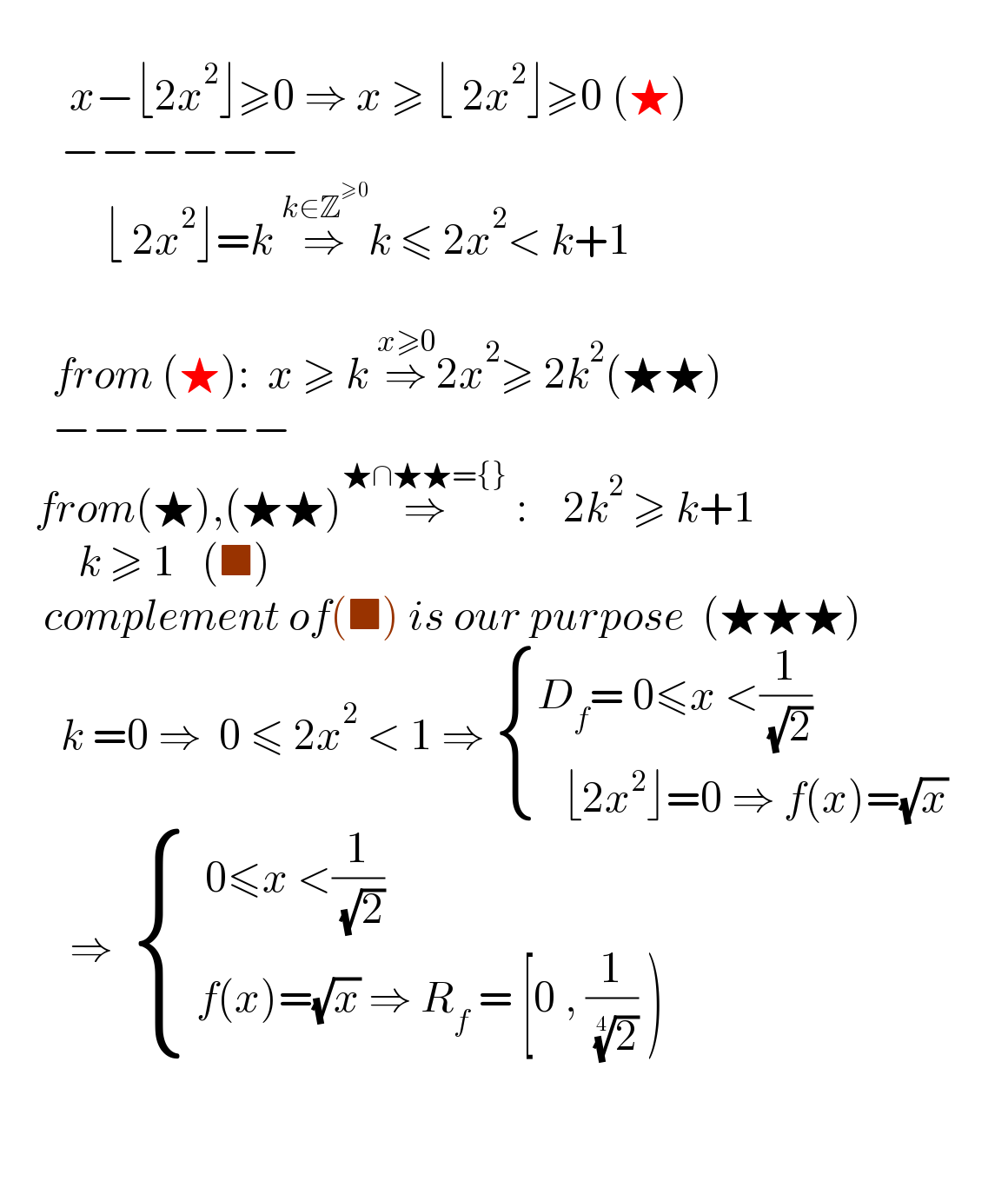
Question Number 208149 by mnjuly1970 last updated on 06/Jun/24

Answered by A5T last updated on 06/Jun/24

$$\lfloor\mathrm{2}{x}^{\mathrm{2}} \rfloor>\mathrm{2}{x}^{\mathrm{2}} −\mathrm{1}\Rightarrow{x}−\lfloor\mathrm{2}{x}^{\mathrm{2}} \rfloor<\mathrm{1}−\mathrm{2}{x}^{\mathrm{2}} +{x} \\ $$$${Suppose}\:{D}_{{f}} ,{R}_{{f}} \subseteq\mathbb{R} \\ $$$$\mathrm{1}−\mathrm{2}{x}^{\mathrm{2}} +{x}<\mathrm{0}\Rightarrow{x}>\mathrm{1}\:{or}\:{x}<−\frac{\mathrm{1}}{\mathrm{2}} \\ $$$${If}\:{R}_{{f}} \subseteq\mathbb{R},\:{then}\:{f}\left({x}\right)\:{is}\:{undefined}\:{for}\:{x}<\frac{−\mathrm{1}}{\mathrm{2}}\cup{x}>\mathrm{1} \\ $$$${when}\:{x}=\frac{−\mathrm{1}}{\mathrm{2}},\mathrm{1};{f}\left({x}\right)\:{is}\:{undefined}\:{in}\:\mathbb{R} \\ $$$$\frac{−\mathrm{1}}{\mathrm{2}}<{x}<\mathrm{0}\Rightarrow\mid{x}\mid<\frac{\mathrm{1}}{\mathrm{2}}\Rightarrow\mathrm{0}<{x}^{\mathrm{2}} <\frac{\mathrm{1}}{\mathrm{4}}\Rightarrow\mathrm{0}<\mathrm{2}{x}^{\mathrm{2}} <\frac{\mathrm{1}}{\mathrm{2}} \\ $$$$\Rightarrow\lfloor\mathrm{2}{x}^{\mathrm{2}} \rfloor=\mathrm{0}\Rightarrow{f}\left({x}\right)=\sqrt{{x}−\mathrm{0}}={f}\left({x}\right)=\sqrt{{x}} \\ $$$${which}\:{is}\:{undefined}\:{for}\:\frac{−\mathrm{1}}{\mathrm{2}}<{x}<\mathrm{0}\:\: \\ $$$${when}\:{x}=\mathrm{0};{f}\left({x}\right)=\mathrm{0} \\ $$$${when}\:\mathrm{0}<{x}<\frac{\mathrm{1}}{\:\sqrt{\mathrm{2}}};\:\lfloor\mathrm{2}{x}^{\mathrm{2}} \rfloor=\mathrm{0}\Rightarrow{f}\left({x}\right)=\sqrt{{x}}\in\left(\mathrm{0},\frac{\sqrt[{\mathrm{4}}]{\mathrm{8}}}{\mathrm{2}}\right) \\ $$$${when}\:{x}=\frac{\mathrm{1}}{\:\sqrt{\mathrm{2}}};{f}\left({x}\right)\:{is}\:{undefined}\:{in}\:\mathbb{R} \\ $$$${when}\:\frac{\mathrm{1}}{\:\sqrt{\mathrm{2}}}<{x}<\mathrm{1},\:\lfloor\mathrm{2}{x}^{\mathrm{2}} \rfloor=\mathrm{1}\Rightarrow{f}\left({x}\right)=\sqrt{{x}−\mathrm{1}} \\ $$$${which}\:{is}\:{undefined}\:{in}\:\mathbb{R}\:{since}\:\frac{\mathrm{1}}{\:\sqrt{\mathrm{2}}}<{x}<\mathrm{1}. \\ $$$${So},{for}\:{D}_{{f}} ,{R}_{{f}} \subseteq\mathbb{R},\:{R}_{{f}} =\left[\mathrm{0},\frac{\sqrt[{\mathrm{4}}]{\mathrm{8}}}{\mathrm{2}}\right),{D}_{{f}} =\left[\mathrm{0},\frac{\mathrm{1}}{\:\sqrt{\mathrm{2}}}\right) \\ $$
Commented by mnjuly1970 last updated on 06/Jun/24

$$ \\ $$
Commented by A5T last updated on 06/Jun/24

$${Do}\:{you}\:{have}\:{the}\:{answer}?\:{Is}\:{it}\:{correct}? \\ $$
Commented by mnjuly1970 last updated on 07/Jun/24

$${yes}\:{sir}\:{A}\mathrm{5}{T} \\ $$
Answered by MM42 last updated on 06/Jun/24

$${D}=\left[\mathrm{0}\:,\:\frac{\mathrm{1}}{\:\sqrt{\mathrm{2}}}\right)\:\:\:\&\:\:{R}=\left[\mathrm{0}\:,\:\frac{\mathrm{1}}{\:\sqrt[{\mathrm{4}}]{\mathrm{2}}}\right) \\ $$$$ \\ $$$$ \\ $$
Commented by MM42 last updated on 06/Jun/24

$${if}\:\:{x}<\mathrm{0}\Rightarrow{x}−\lfloor\mathrm{2}{x}^{\mathrm{2}} \rfloor<\mathrm{0}\Rightarrow\notin\:{D}_{{f}} \\ $$$${if}\:\:\:\sqrt{\frac{{n}}{\mathrm{2}}\:}\leqslant{x}<\sqrt{\frac{{n}+\mathrm{1}}{\mathrm{2}}}\:\Rightarrow{x}<{n}\:\:\:;\:\forall{n}\in\mathbb{N} \\ $$$$\Rightarrow{n}\leqslant\mathrm{2}{x}^{\mathrm{2}} <{n}+\mathrm{1}\Rightarrow\lfloor\mathrm{2}{x}^{\mathrm{2}} \rfloor={n} \\ $$$$\Rightarrow{x}−\lfloor\mathrm{2}{x}^{\mathrm{2}} \rfloor<\mathrm{0}\Rightarrow\notin\:{D}_{{f}} \\ $$$${f}\left(\mathrm{0}\right)=\mathrm{0}\:\:\&\:{lim}_{{x}\rightarrow\frac{\mathrm{1}}{\:\sqrt{\mathrm{2}}}\:^{} } {f}\left({x}\right)=\frac{\mathrm{1}}{\:\sqrt[{\mathrm{4}}]{\mathrm{2}}} \\ $$$$\Rightarrow{R}_{{f}} =\left[\mathrm{0},\frac{\mathrm{1}}{\:\sqrt[{\mathrm{4}}]{\mathrm{2}}}\right) \\ $$
Answered by mnjuly1970 last updated on 07/Jun/24

$$\:\: \\ $$$$\:\:\:\:\:\:\:\:{x}−\lfloor\mathrm{2}{x}^{\mathrm{2}} \rfloor\geqslant\mathrm{0}\:\Rightarrow\:{x}\:\geqslant\:\lfloor\:\mathrm{2}{x}^{\mathrm{2}} \rfloor\geqslant\mathrm{0}\:\left(\bigstar\right) \\ $$$$\:\:\:\:\:\:\:−−−−−− \\ $$$$\:\:\:\:\:\:\:\:\:\:\:\:\lfloor\:\mathrm{2}{x}^{\mathrm{2}} \rfloor={k}\:\overset{{k}\in\mathbb{Z}^{\geqslant\mathrm{0}} } {\Rightarrow}{k}\:\leqslant\:\mathrm{2}{x}^{\mathrm{2}} <\:{k}+\mathrm{1} \\ $$$$\:\:\:\:\:\:\:\:\: \\ $$$$\:\:\:\:\:\:{from}\:\left(\bigstar\right):\:\:{x}\:\geqslant\:{k}\:\overset{{x}\geqslant\mathrm{0}} {\Rightarrow}\mathrm{2}{x}^{\mathrm{2}} \geqslant\:\mathrm{2}{k}^{\mathrm{2}} \left(\bigstar\bigstar\right) \\ $$$$\:\:\:\:\:\:−−−−−− \\ $$$$\:\:\:\:{from}\left(\bigstar\right),\left(\bigstar\bigstar\right)\overset{\bigstar\cap\bigstar\bigstar=\left\{\right\}} {\Rightarrow}\::\:\:\:\:\mathrm{2}{k}^{\mathrm{2}} \:\geqslant\:{k}+\mathrm{1} \\ $$$$\:\:\:\:\:\:\:\:\:{k}\:\geqslant\:\mathrm{1}\:\:\:\left(\blacksquare\right)\: \\ $$$$\:\:\:\:\:{complement}\:{of}\left(\blacksquare\right)\:{is}\:{our}\:{purpose}\:\:\left(\bigstar\bigstar\bigstar\right) \\ $$$$\:\:\:\:\:\:\:{k}\:=\mathrm{0}\:\Rightarrow\:\:\mathrm{0}\:\leqslant\:\mathrm{2}{x}^{\mathrm{2}} \:<\:\mathrm{1}\:\Rightarrow\:\begin{cases}{{D}_{{f}} =\:\mathrm{0}\leqslant{x}\:<\frac{\mathrm{1}}{\:\sqrt{\mathrm{2}}}}\\{\:\:\:\lfloor\mathrm{2}{x}^{\mathrm{2}} \rfloor=\mathrm{0}\:\Rightarrow\:{f}\left({x}\right)=\sqrt{{x}}}\end{cases}\:\:\:\:\:\:\: \\ $$$$\:\:\:\:\:\:\:\:\Rightarrow\:\:\begin{cases}{\:\:\mathrm{0}\leqslant{x}\:<\frac{\mathrm{1}}{\:\sqrt{\mathrm{2}}}}\\{\:{f}\left({x}\right)=\sqrt{{x}}\:\Rightarrow\:{R}_{{f}} \:=\:\left[\mathrm{0}\:,\:\frac{\mathrm{1}}{\:\sqrt[{\mathrm{4}}]{\mathrm{2}}}\:\right)}\end{cases} \\ $$$$ \\ $$$$\:\:\:\:\:\: \\ $$
